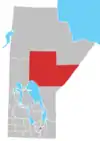Nisichawayasihk Cree Nation
The Nisichawayasihk Cree Nation (formerly the Nelson House First Nation) is a Cree-speaking community of about 4,200 Cree centered in Nelson House, Manitoba, Canada. Nelson House is located about 80 kilometres (50 mi) west of Thompson and is accessible via the mixed paved and gravel Provincial Road 391. Nisichawayasihk means where three rivers meet in Cree and describes Nelson House which is located at the convergence of the Burntwood River, Footprint and Rat Rivers.
| People | Cree |
|---|---|
| Treaty | Treaty 5 |
| Headquarters | Nelson House |
| Province | Manitoba |
| Land[1] | |
| Main reserve | Nelson House 170 |
| Other reserve(s) |
|
| Land area | 237.088 km2 |
| Population (October 2019)[1] | |
| On reserve | 2997 |
| On other land | 156 |
| Off reserve | 2129 |
| Total population | 5282 |
| Government[1] | |
| Chief | Marcel Moody[2] |
| Council |
|
| Website | |
| https://www.ncncree.com/ | |
History
The people of Nisichawayasihk are largely ancestral descendants of indigenous Cree peoples who have populated the Canadian Shield region of northern and central Canada since the retreat of the glaciers about 10,000 years ago.
Largely left alone by the Government of Canada during initial colonization and settlement of Western Canada. In the mid-1870s, the Indigenous peoples of the Lake Winnipeg area were interested in making a treaty with the Government of Canada. They had heard about the concessions offered to the Indigenous nations of Treaties 1 to 4 (see Numbered Treaties), and subsequently demanded the government provide similar economic assistance, provisions of tools and protection against the encroachment of outsiders (such as surveyors and settlers) on their territories. Treaty 5 was the response from the government that ensure the homelands of the Cree were protected for their use.[3] Treaty 5, a document which established that Nisichawayasihk Cree Nation members and their descendants were guaranteed certain rights and benefits.
Governance and population
Nisichawayasihk Cree Nation is governed by an elected chief and council. Elections are held pursuant to NCN's own democratic election code. The last election in Nelson House was in July 2014. The Chief is currently Marcel Moody, a former Councillor.
About 3,000 members of the NCN live in Nelson House and the remaining 2,100 off the reserve lands. Until 2005, the community of South Indian Lake on the shores of Southern Indian Lake was also part of the NCN. In December 2005, this community of about 1,100 persons separated from the Nisichawayasihk Cree Nation to form the O-Pipon-Na-Piwin Cree Nation.
With a population of approximately 5,200, the NCN is a large and widespread community. Nelson House consists of nine areas, which are known to the residents as Hillside, Dogpoint, R.C. Point, Little R.C. Point, New Area, Hart's Point, Michelle Point, Bay Road and Moore's Bay.
Like most of rural Canada where the population is sparse, there is no local infrastructure for water and sewage treatment. Rural residents in Canada must use private wells or take water from a lake or river and have their own septic tank.
Hydroelectric development and impacts
During the 1960s and 1970s, the Government of Manitoba and Manitoba Hydro began the Nelson River Hydroelectric Project, centered on the Churchill and Nelson rivers. The project included the Churchill River Diversion, which directly affected Nisichawayasihk members living at Nelson House and at South Indian Lake. Consequently, large areas of traditional hunting, fishing and trapping lands were flooded. The people of South Indian Lake were forcibly relocated to their current location.
The Nisichawayasihk Cree Nation (NCN) is a signatory to the Northern Flood Agreement (NFA) between Canada (the federal government), Manitoba Hydro, the Province of Manitoba and several First Nations Communities. In 1996, NCN signed an NFA Implementation Agreement. Using settlement proceeds paid pursuant to this implementation agreement, NCN purchased the Mystery Lake Motor Hotel in the nearby city of Thompson. In 2006, the NCN signed a Project Development Agreement with Manitoba Hydro regarding the Wuskwatim hydroelectric project on the Burntwood River, about 30 km from Nelson House. Wuskwatim generates about 200 MW of electricity. The NCN was involved in the construction of the project and, as a partner in the project, will receive a share of the future revenues. This arrangement is the first of its kind in Manitoba.
In 2006, the Atoskiwin Training and Employment Centre (ATEC) opened its doors in Nelson House. ATEC is also a Manitoba first. It trains NCN members and other aboriginals for northern hydro projects and other job opportunities.
Urban reserve
In early February 2004, the nearby city of Thompson, Manitoba announced its approval to the NCN to convert a parcel of property to Treaty Land. This was possible due to shortages in land area controlled by NCN under the Treaty Land Entitlement agreement in the mid-1990s. This event will mark one of the few transitions from privately owned land, purchased by a First Nations community, to an Urban Reserve.
This plan has been quietly discussed between city and band administration since the narrowly lost plebiscite held in Thompson on September 18, 2001. With a 45% voter turnout for the plebiscite, and amid allegations of inappropriate voter disqualifications, the "no" side won by a margin of 250 votes. During the three years following the plebiscite, the majority of Thompson City Councillors have publicly stated that the results of the vote were not binding upon city council, as the council has been elected to act in the best interests of the citizens of Thompson.
References
- "Nisichawayasihk Cree Nation". First Nation Details. Indigenous and Northern Affairs Canada. 26 September 2019.
- "Current Chief and Council". Nisichawayasihk Cree Nation.
- Filice, Michelle (1 February 2018). "Treaty 5". The Canadian Encyclopedia (online ed.). Historica Canada.
